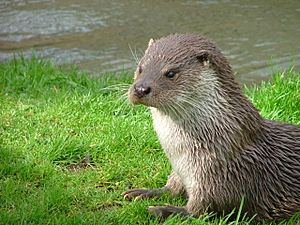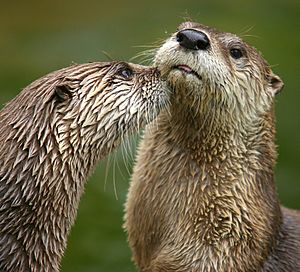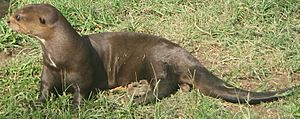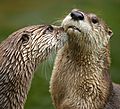Otter facts for kids
Quick facts for kids OtterTemporal range: Middle Miocene to present
|
|
|---|---|
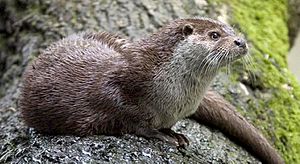 |
|
| Eurasian otter (Lutra lutra) | |
| Scientific classification |
|
| Kingdom: | Animalia |
| Phylum: | Chordata |
| Class: | Mammalia |
| Order: | Carnivora |
| Family: | Mustelidae |
| Subfamily: | Lutrinae Bonaparte, 1838 |
| Type genus | |
| Lutra Brünnich, 1771
|
|
| Genera | |
|
Aonyx |
|
Otters are meat-eating mammals that belong to the Lutrinae group. There are 13 types of otters alive today. All of them live in or near water, like rivers, lakes, or the ocean. They mostly eat fish and small water creatures called invertebrates. Otters are part of the Mustelidae family, which also includes animals like weasels, badgers, and mink.
Contents
What is an Otter?
Otters have long, thin bodies and short legs. They have strong webbed feet that help them swim very well. Most otters have sharp claws and long, strong tails. The 13 different otter species vary in size. They can be from about 2 feet to 6 feet long. Their weight can range from 2 pounds to 100 pounds. The Asian small-clawed otter is the smallest. The giant otter and sea otter are the biggest.
Otters have very soft fur that keeps them warm. This fur has two layers. The inner layer is thick and insulated. The outer layer has long guard hairs. This special fur traps air, which keeps them dry and warm underwater. It also helps them float.
How Otters Stay Warm
Many otters live in cold water. They have a fast metabolism to stay warm. This means their bodies burn a lot of energy. For example, European otters need to eat 15% of their body weight every day. Sea otters need to eat even more, about 20-25% of their body weight daily. If the water is 50°F (10°C), an otter needs to catch about 3.5 ounces (100 grams) of fish every hour to survive. Most otters hunt for three to five hours each day. Mothers feeding their babies might hunt for up to eight hours.
Otter Homes and Families
An otter's home is called a holt or a couch. They often build their holts under tree roots or in rocky piles. These homes are lined with soft moss and grass.
The Otter Life Cycle
Baby otters are born after about 60 to 86 days. Both parents and older siblings help take care of the newborn pups. Female otters can have babies when they are about two years old. Males are ready to have babies around three years old.
After one month, a baby otter can leave its holt. By two months old, it can swim. Young otters stay with their family for about one year. Otters can live up to 16 years. They are known for being playful. They love to frolic and play in the water with their pups.
What Do Otters Eat?
Most otters mainly eat fish. They also enjoy frogs, crayfish, and crabs. Some otters are very good at opening shellfish. Others might eat small mammals or birds if they can find them. Otters depend on their food sources. If there isn't enough food, their populations can suffer.
Sea otters are special hunters. They eat clams, sea urchins, and other shelled creatures. They are famous for using stones to break open shellfish. They place the shell on their stomach and hit it with a rock. This is a skill that young sea otters must learn from their parents.
Otters are active hunters. They chase prey in the water. They also search the bottom of rivers, lakes, or the sea. Most otter species live near water. However, river otters usually only go into the water to hunt or travel. They spend a lot of time on land to keep their fur from getting too wet. Sea otters are different; they spend most of their lives in the ocean.
Otter Behavior
Otters are very playful animals. They seem to do things just for fun. For example, they make waterslides and slide into the water. They also like to find and play with small stones.
Different otter species have different ways of living together. Some otters prefer to live alone. Others live in groups. In some species, these groups can be quite large.
Types of Otters
|
Otters Alive Today
| Image | Genus | Species |
|---|---|---|
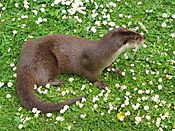 |
Lutra Brisson, 1762 |
|
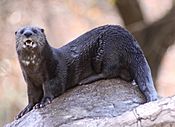 |
Hydrictis Pocock, 1921 |
|
 |
Lutrogale (Gray, 1865) |
|
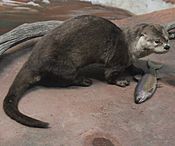 |
Lontra Gray, 1843 |
|
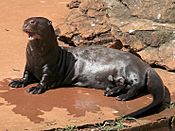 |
Pteronura Gray, 1837 |
|
 |
Aonyx Lesson, 1827 |
|
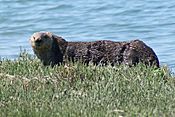 |
Enhydra Fleming, 1828 |
|
European Otter
The European otter (Lutra lutra) lives in Europe, most of Asia, and parts of North Africa. In the British Isles, they were common until the 1950s. Then, their numbers dropped because of harmful chemicals, loss of their homes, and water pollution. They were still common in parts of Scotland and Ireland. By the 1980s, their population was very low.
Now, European otter numbers are growing again. There is a plan to help them return to all the UK rivers and coastal areas they lived in by 1960. Sadly, otters being hit by cars on roads is now a big threat to their recovery.
North American River Otter
The North American river otter (Lontra canadensis) was once widely hunted for its fur in North America. These otters eat many types of fish and shellfish. They also eat small land mammals and birds. They can grow to about 3 to 4 feet long. Their weight ranges from 10 to 30 pounds.
In some places, the North American river otter is a protected animal. There are also otter sanctuaries. These places help sick and injured otters get better.
Sea Otter

Sea otters (Enhydra lutris) are marine mammals. They live along the Pacific coast of North America. Their historic range included areas like the Bering Strait and Japan. Sea otters have incredibly thick fur. They have between 26,000 and 165,000 hairs per square centimeter of skin. People hunted them for this valuable fur, almost causing them to disappear. By 1911, when a treaty protected them, so few sea otters were left that hunting them was no longer profitable.
Sea otters eat shellfish and other invertebrates. This includes clams, abalone, and sea urchins. Otter populations are affected by how much food is available. More otters tend to live in rocky areas. It is easier to dig out prey from rocky bottoms than from soft, muddy bottoms. Sea otters are one of the few animals that use tools. They often carry a rock in a pouch under their arm. They use this rock to smash open shells.
Sea otters are different from most marine mammals. They do not have a thick layer of fat called blubber to keep warm. Instead, they rely on the air trapped in their fur. They blow into their fur to keep it full of air. Unlike other otters, sea otters spend most of their lives in the water.
Giant Otter
The giant otter (Pteronura brasiliensis) lives in South America. They are mostly found in the Amazon river basin. However, they are becoming rare. This is due to illegal hunting, loss of their homes, and pollution from gold mining. These otters are very social animals. They can grow up to 6 feet long. They spend more time in the water than most other otters.
Otters and People
People have hunted otters for their pelts (furs) for hundreds of years. Early hunters used darts, arrows, nets, and snares. Later, people used traps and guns. Otter furs were very popular around the world. In China, royalty wore robes made from otter fur. People with high social status also wore them. Otter tails were often made into hats and belts for men. Even some children's mittens were made from otter fur.
Otters have also been hunted using dogs, especially a breed called the otterhound. In England and Wales, otter hunts killed many otters in the past. Today, hunting otters is much less common.
Sadly, otters in Southeast Asia are still at serious risk. They have disappeared from some areas where they used to live. This is because of hunting to supply the demand for their skins.
Otters Helping Fishermen
For many generations, fishermen in southern Bangladesh have worked with smooth-coated otters. They train the otters to chase fish into their nets. This traditional practice was once common across Asia. Today, it is still done in the Narail District of Bangladesh. It is a unique way that people and wild animals work together.
Otter Attacks
Otters can be territorial. In some areas, like Florida, both otter and human populations have grown. A study showed that most otter attacks between 1875 and 2010 happened in Florida. Most involved the North American otter. At least 42 attacks were reported. In one case, a person died, and another was seriously injured. Sometimes, the otters involved had rabies. Animal welfare groups say that otters rarely attack humans unless they feel threatened.
In November 2021, a man in Singapore was attacked by about 20 otters. He was bitten and trampled. He thought another runner might have stepped on one of the otters earlier.
Otters in Stories and Beliefs
Otters appear in many old stories and myths.
Myths and Legends
In Norse mythology, there is a dwarf named Ótr who often turned into an otter. The story of "Otter's Ransom" is a key part of the Volsunga saga.
In Irish mythology, a woman named Lí Ban was turned into a mermaid. Her pet dog became an otter. They both lived for 300 years and traveled the oceans together.
Some Native American cultures see otters as totem animals. This means otters are special symbols for their groups.
In Zoroastrianism, otters are seen as clean animals belonging to Ahura Mazda. It is forbidden to kill them.
In Korean mythology, it is said that people who see an otter will attract "rain clouds" for the rest of their lives.
In Buddhist Jataka tales, there's a story called "The Otters and The Wolf." Two otters asked a wolf to divide their fish, but the clever wolf took all the fish for himself.
Japanese Folklore
In Japan, otters are called "kawauso" (獺、川獺). In Japanese folk stories, they are known to trick humans. They are similar to foxes (kitsune) and tanuki in this way.
In the Noto region of Ishikawa Prefecture, there are tales of otters changing into beautiful women or children wearing checkered clothes. If someone tries to talk to them, they might say strange things. Some stories are darker. In one tale from Kaga Province, an otter living in a castle's moat turned into a woman. She would invite men, then kill and eat them.
Old Japanese writings from the Edo period also tell stories of otters changing into beautiful women to trick and kill men.
In some parts of Hiroshima Prefecture, otters are called "tomo no kawauso" and "ato no kawauso." They are said to turn into monks and appear to people walking by. If someone tries to get close, the otter-monk grows taller and taller.
In the Tsugaru region of Aomori Prefecture, people believe otters can possess humans. Those possessed by otters are said to lose their energy, as if their soul has been taken.
In other parts of Ishikawa Prefecture, otters are seen as a type of yōkai (a supernatural creature) called kabuso or kawaso. They play tricks, like putting out the lights of people walking at night. They might also change into a beautiful young woman to fool people. Sometimes, they trick people into trying to sumo wrestle a rock or a tree stump. It is said they can speak human words and sometimes call out to people on the road.
In Ishikawa and Kochi Prefectures, otters are sometimes seen as a type of kappa (a water spirit). There are stories of people sumo wrestling with otters. An old dictionary from the Muromachi period says that an old otter becomes a kappa.
An Ainu folktale from Hokkaidō tells of monster otters. They change into humans and go into homes with pretty girls. They try to kill the girl and make her their wife.
In China, like in Japan, old books also have stories of otters changing into beautiful women.
Images for kids
See also
 In Spanish: Nutrias para niños
In Spanish: Nutrias para niños


